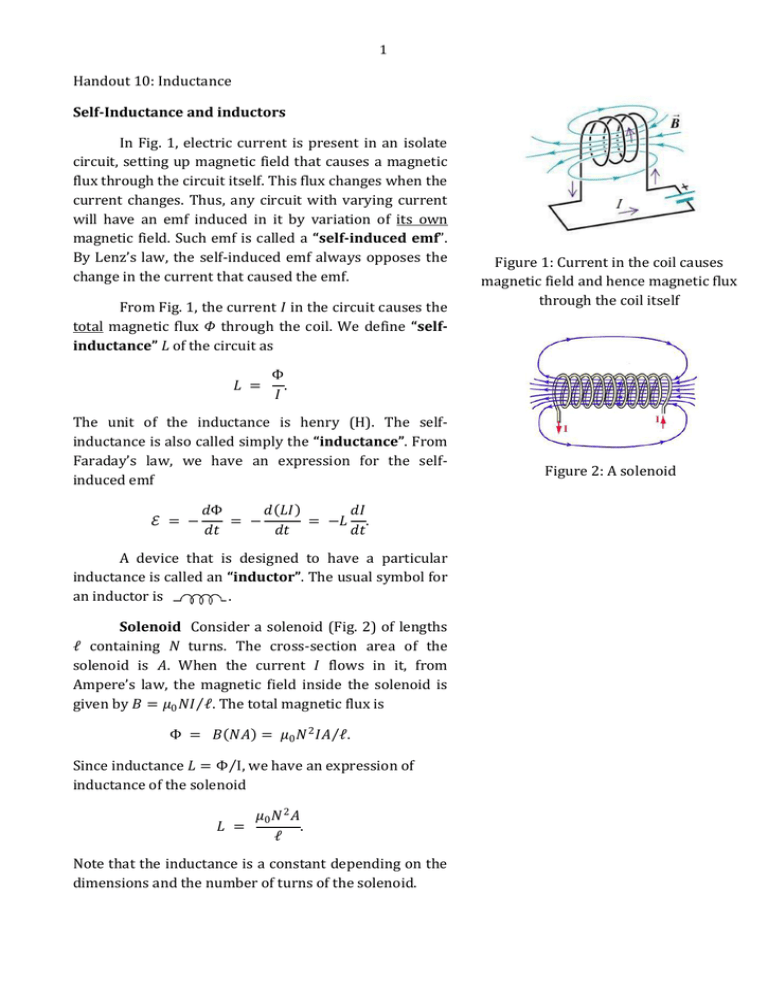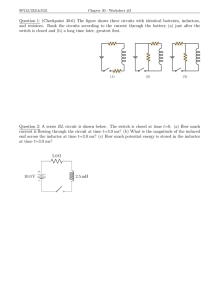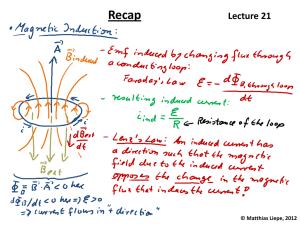Handout 10
advertisement

1 Handout 10: Inductance Self-Inductance and inductors In Fig. 1, electric current is present in an isolate circuit, setting up magnetic field that causes a magnetic flux through the circuit itself. This flux changes when the current changes. Thus, any circuit with varying current will have an emf induced in it by variation of its own magnetic field. Such emf is called a “self-induced emf”. By Lenz’s law, the self-induced emf always opposes the change in the current that caused the emf. From Fig. 1, the current 𝐼 in the circuit causes the total magnetic flux 𝛷 through the coil. We define “selfinductance” L of the circuit as 𝐿 = Φ . 𝐼 The unit of the inductance is henry (H). The selfinductance is also called simply the “inductance”. From Faraday’s law, we have an expression for the selfinduced emf ℰ = − Figure 1: Current in the coil causes magnetic field and hence magnetic flux through the coil itself 𝑑Φ 𝑑 𝐿𝐼 𝑑𝐼 = − = −𝐿 . 𝑑𝑡 𝑑𝑡 𝑑𝑡 A device that is designed to have a particular inductance is called an “inductor”. The usual symbol for an inductor is . .. Solenoid Consider a solenoid (Fig. 2) of lengths ℓ containing N turns. The cross-section area of the solenoid is 𝐴. When the current 𝐼 flows in it, from Ampere’s law, the magnetic field inside the solenoid is given by 𝐵 = 𝜇0 𝑁𝐼 ℓ. The total magnetic flux is Φ = 𝐵 𝑁𝐴 = 𝜇0 𝑁 2 𝐼𝐴 ℓ. Since inductance 𝐿 = Φ I, we have an expression of inductance of the solenoid 𝜇0 𝑁 2 𝐴 𝐿 = . ℓ Note that the inductance is a constant depending on the dimensions and the number of turns of the solenoid. Figure 2: A solenoid 2 Example 1 A cylindrical solenoid of length 0.50 m contains 150 turns. The radius of the solenoid is 2.0 cm. Calculate the inductance. Example 2 An inductor has inductance 0.26 H and carries a current what is increasing at uniform rate 0.015 As-1. Determine the self-induced emf. Example 3 An air-core toroid with cross-section area A and mean radius 𝑅 is closely wound with N turns. a) Show that the inductance is given by 𝐿 = 𝜇0 𝑁 2 𝐴 . 2𝜋𝑅 b) Suppose 𝑁 = 200 turns, 𝐴 = 5.0 cm2 and 𝑅 = 0.1 m, calculate 𝐿. Energy stored in inductor Because of the self-induced emf ℰ, the voltage across the inductor is 𝑉 = 𝐿 𝑑𝐼 𝑑𝑡 . The energy is transferred to the inductor at rate 𝑃 = 𝐼𝑉 = 𝐿𝐼 𝑑𝐼 𝑑𝑡 . The energy supplied, 𝑈, is equal to the integral 𝑃𝑑𝑡. While the current increases from zero to any 𝐼, the energy store is given by 𝐼 1 2 𝐿𝐼 . 2 0 It must be noted that resistors and inductors behave differently. When the current (either increasing 𝑈 = 𝐿𝐼 𝑑𝐼 = 3 or decreasing) passes through a resistor, energy is dissipated as heat. By contrast, when the current in the inductor is increasing, the energy is stored in the inductor. When the current is decreasing, the energy is released from the inductor. When the current is constant, there is no energy flow in or out. Solenoid Self-inductance of a solenoid is given by 𝐿 = 𝜇0 𝑁 2 𝐴 ℓ. Therefore, the energy stored 1 2 1 𝜇0 𝑁 2 𝐴 2 1 𝜇0 𝑁𝐼 𝑈 = 𝐿𝐼 = 𝐼 = 2 2 ℓ 2𝜇0 ℓ 2 𝐴ℓ . Since 𝜇0 𝑁𝐼 ℓ = 𝐵 inside the solenoid and 𝐴ℓ is the volume of the solenoid. The energy density (energy per unit volume), is given by 𝑢 = 𝑈 𝐵2 = . 𝐴ℓ 2𝜇0 This is a general expression for energy density stored in magnetic field. It should be compared with expression for energy density stored in electric field 𝑢 = 1 2 𝜀0 𝐸 2 (see handout 4). Example 4 A electric-power industry wants to store energy in a large inductor. What inductance would be needed to store 1.00 kW h-1 of energy in a coil carrying a 200-A current? Example 5 On average, electromagnetic waves contain equal amount of magnetic energy density and electric energy density. Determine the ratio of electric field 𝐸 to to magnetic field 𝐵. Comment on this result. 4 RL circuit Circuit in Fig. 3 consists of a battery with emf 𝓔, a resistor with resistance 𝑅 and an inductor with inductance 𝐿. Initially, the switch 𝑆1 and 𝑆2 are open. When 𝑆1 is closed, the current 𝐼 flows from the battery and it is increasing from zero. At any instant, the voltage across the resistor is 𝑉𝑅 = 𝐼𝑅 and the selfinduced emf of the inductor is ℰ𝐿 = −𝐿 𝑑𝐼 𝑑𝑡 . From Kirchhoff’s law, 𝐸 = 𝑉, ℰ−𝐿 𝑑𝐼 = 𝐼𝑅 𝑑𝑡 ⟹ − Figure 3: RL circuit 𝐿 𝑑𝐼 ℰ = 𝐼− . 𝑅 𝑑𝑡 𝑅 We can solve the above equation as follows: 𝐼 0 𝑡 𝑑𝐼 = − 𝐼− ℰ 𝑅 𝐼 ℰ ln 𝐼 − 𝑅 0 𝐼− ℰ 𝑅 ln −ℰ 𝑅 = − 0 𝑅 𝑑𝑡 𝐿 𝑅 𝑡 𝐿 Figure 4: The maximum current ℰ 𝑅 . After one time constant 𝜏, the current is 1 − 1 𝑒 ≃ 63% of the final value 𝑅 = − 𝑡. 𝐿 The above equation can be rearranged, yielding current 𝐼 as a function of time 𝑡: 𝐼 = ℰ 1 − 𝑒− 𝑅 𝑅 𝐿 𝑡 . The current increases with time and it reaches the maximum value ℰ 𝑅 as 𝑡 ⟶ ∞. This can be seen from the graph in Fig. 4. The time constant for an RL circuit is defined as 𝜏 = 𝑅 𝐿. When 𝑡 = 𝜏, the current is 1 − 1 𝑒 ≃ 63% of the maximum value. When the switch 𝑆1 in Fig. 3 has been closed for a while and that the current reaches the maximum value 𝐼 = ℰ 𝑅 . The switch 𝑆1 is open and 𝑆2 is closed at the same time. From Kirchhoff’s law, −𝐿 𝑑𝐼 = 𝐼𝑅. 𝑑𝑡 The initial current is 𝐼 = ℰ 𝑅 . One can solve the above equation to obtain Figure 5: The decay of current in an RL circuit. 5 𝐼 = ℰ −𝑅 𝑒 𝑅 𝐿 𝑡 . This equation is plotted in Fig. 5. When 𝑡 = 𝜏, the current is 1 𝑒 ≃ 37% of the initial value. LC circuit An LC circuit, consisting of an inductor and a capacitor, is an example of oscillatory circuit. The charge can current oscillates in time, in contrast to the RL circuit where the current and charge vary exponentially with time. Consider an LC circuit in Fig. 6. Initially, the capacitor has charge 𝑞0 and the switch is open. When the switch is closed, the charge flows from the capacitor to the inductor. The potential difference across the capacitor is 𝑞 𝐶 . The increasing current in the inductor causes a self-induced emf ℰ𝐿 = −𝐿 𝑑𝐼 𝑑𝑡 . The current can be written as 𝐼 = 𝑑𝑞 𝑑𝑡. From Kirchhoff’s law, 𝐿 𝑑𝐼 𝑞 + = 0 𝑑𝑡 𝑐 ⇒ Figure 6: LC circuit 𝑑2 𝑞 𝑞 + = 0. 𝑑𝑡 2 𝐿𝐶 The above equation looks like a SHM equation for electric charge 𝑞 with angular frequency 𝜔 = 1 𝐿𝐶 . The solution, subject to the initial condition 𝑞 0 = 𝑞0 , is given by Figure 7: Oscillating charge of LC circuit with period 𝑇 = 2𝜋 𝜔 = 2𝜋 𝐿𝐶 𝑞 = 𝑞0 cos 𝜔𝑡. The amplitude of charge oscillation is 𝑞0 . The variation of charge is illustrated in Fig. 7. The current varies as 𝐼 = 𝑑𝑞 = −𝜔𝑞0 sin 𝜔𝑡. 𝑑𝑡 The amplitude of the current is 𝜔𝑞0 and the phase of the current differs from that of charge by 𝜋 2. Figure 8 shows the graphs of energy against time. The energy in the capacitor is given by 𝑈𝐶 = 𝑞2 𝑞02 = cos 2 𝜔𝑡, 2𝐶 2𝐶 and the energy in the inductor by Figure 8: Variation of energies stored in capacitor, inductor and total energy over time. 6 𝑈𝐿 = 1 2 1 𝑞02 𝐿𝐼 = 𝐿𝜔2 𝑞02 sin2 𝜔𝑡 = sin2 𝜔𝑡. 2 2 2𝐶 The total energy 𝑈𝐶 + 𝑈𝐿 = 𝑞02 2𝐶 is constant over time. Therefore, there is no energy lost. RLC circuit in series In the LC circuit, the total energy is constant and the charge in the capacitor oscillates with constant amplitude. Introducing a resistor into the circuit will cause energy lost and, hence, the amplitude of charge oscillation decreases with time. This is analogous to damped harmonic oscillator in mechanics. Consider an RLC circuit shown in Fig. 9. Intially, the charge 𝑞0 is stored in the capacitor. The capacitor discharges. The voltage across the capacitor is 𝑞 𝐶 . The induced emf across the inductor is ℰ𝐿 = −𝐿 𝑑𝐼 𝑑𝑡 . The voltage across the resistor is 𝐼𝑅. From Kirchhoff’s law, −𝐿 Figure 9: RLC circuit 𝑑𝐼 𝑞 − = 𝐼𝑅. 𝑑𝑡 𝑐 By writing 𝐼 = 𝑑𝑞 𝑑𝑡, Kirchhoff’s law can be expressed in the form 𝑑 2 𝑞 𝑅 𝑑𝑞 1 + + 𝑞 = 0. 2 𝑑𝑡 𝐿 𝑑𝑡 𝐿𝐶 This second-order differential equation is analogous to damped harmonic motion where the mass is replaced by the charge 𝑞. The solution is different for the underdamped (small 𝑅) and overdamped (large 𝑅) cases. Here we are interested in a specific case when 𝑅 2 < 4𝐿 𝐶 . The solution takes the form 𝑞 = 𝑞0 𝑒 −(𝑅 2𝐿)𝑡 cos 𝜔𝑡 , 𝜔 = 1 𝑅2 − 2. 𝐿𝐶 4𝐿 The plot of charge against time is shown in Fig. 10. The amplitude of the oscillation decreases exponentially. Figure 10: Graph of charge against time for an underdamped RLC circuit







